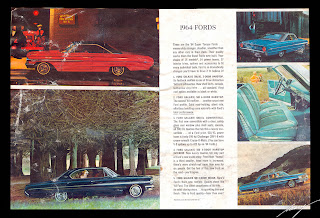I'm especially taken with this bright red GT hardtop coupe, with the black half vinyl roof, bottom. There is just enough chrome trim and detailing on it to make it stand out for all the right reasons. The black vinyl bucket seat interior is really fetching as well! The well-drawn proportions of the base models at the top illustrate how important it is to get the car "right" before you add any extra trim to it. Chrome accents and two- or three-tone paint can set a car off, but they can't be used to make a poorly proportioned vehicle "right." The same holds true with so many disciplines in the creative world. When I was designing publications full time and leading an art department, I could never stress enough to my artists that they get the basic design of the page, or cover, correct, before they started adding details like shadows or colors. Many of them would try to "wow" me with typographic "tricks" right away before they got the layout right, and believe me, you really can't "save" a bad design with filigree or "pretty clutter!" Click to enlarge to full-screen.
M Y C O L L E C T I O N — In 1965, Dodge's smallest car was the Dart, available in three series: Base, mid-level 270 and "luxury" GT. Body styles ran the full sixties gamut, from 2- and 4-door sedans, to 2 door pillarless coupes, convertibles and 4-door wagons. They were available with six- and eight-cylinder engines with ratings from 101 hp to 235 hp, 3- and 4-speed manuals or an automatic transmission.
Though they seemed small back then, seen in today's light, their 111" wheelbase (106" on wagons, shared with the Plymouth Valiant) place them squarely in the mainstream of 21st century sedans. Their curb weights of approximately 2,800-3,000 lbs are much lighter than similar-sized cars of today, but that's largely the result of all of the added safety equipment and crash structures our cars must now possess. Though the '65 model's styling shown is credited to Elwood Engel, the basic chassis and proportions date back to Virgil Exner's sensational 1960 Valiant.
Engel's philosophy was to "fill out the square" in both silhouette and plane views, but there is a humble honesty to these cars that's very appealing. The hood and trunk lengths are just about perfect, the greenhouse and roof shapes are attractive, and the chrome strip that wraps from the taillights up and over the rear window on the pillarless coupes is really well done. The half vinyl roof seems a bit flamboyant, almost Exner like, and wouldn't really catch on with the rest of the industry for several more years, becoming more of a seventies cliché. It's just about perfectly executed on this Dart GT.
One is lucky today if a car is available in anything but a 4-door sedan, and if it is, the additional body style is usually a tall wagon. With all the advancements in computer-aided design and electronic "robotic" construction, I just find it odd all we can seemingly come up with are sedans. To top it off they're usually painted gray with a gray interior. Even though this was Dodge's least expensive, and smallest car, it came in a full panoply of body styles and trim levels. Interiors came in several color choices, usually red, green, blue, beige, white and black, and in a choice of cloth or vinyl—we hadn't yet felt it necessary to skin a cow for every single car in the 1960s.
B T W :
I just remembered I've photoshopped one of these 1963-'66 Darts before. This is a 1963 Dart convertible in which I smoothed out the sides a bit, and added fender skirts for that proper "Cruiser" look. I chopped down the windshield a little to give the car a longer, lower appearance. I also dropped it closer to the ground a few inches and upped the wheel size, though I kept the sixties wheelcovers and white walls.
















































